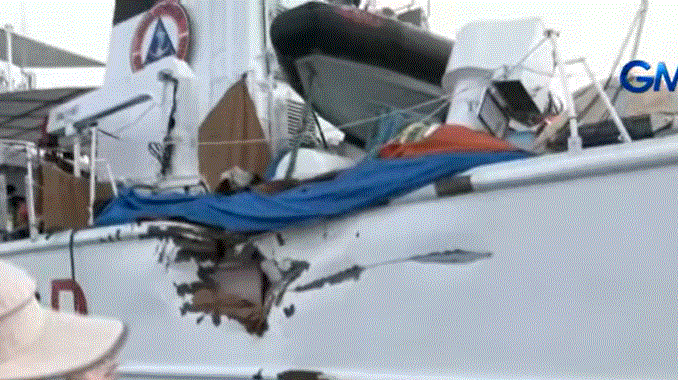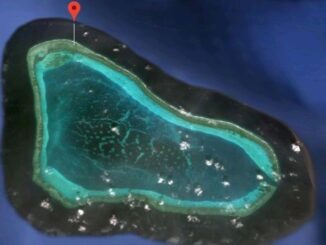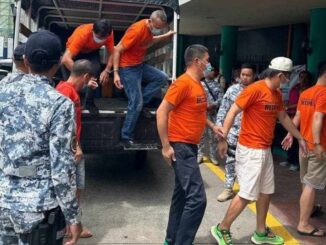
The recent incident involving the BRP Bagacay and the BRP Cape Engaño may be considered the worst crash incident experienced by the Philippine Coast Guard (PCG), according to Commodore Jay Tarriela.
“This is the worst intentional ramming that was done by Chinese Coast Guard (CCG) that resulted in such structural damage putting holes in our two Coast Guard vessels,” Tarriela said in a report by Ian Cruz on “24 Oras.”
Upon BRP Bagacay’s arrival near Pag-asa Island on Tuesday, a big patch of canvas was noticeably covering the port side of the vessel after CCG vessel 21551 crashed into it near the Escoda Shoal early morning on Monday.
The magnetized canvas is currently being used to patch the damage and prevent water from entering the ship through the 2.5 foot-long and 3-feet wide hole at the auxiliary room near the auxiliary engine.
Other than the hole, the railings at the back of the starboard and the front of the vessel, which was the first to hit vessel CCG 3401 after it hit BRP Cape Engaño, were also damaged.
The BRP Cape Engaño sustained a hole at the back of the starboard.
Despite the incident, the morale of the PCG troops remains high as they keep on standby for duty at the West Philippine Sea.
The BRP Bagacay has since returned to Palawan’s mainland on Wednesday, while the BRP Cape Engaño is finishing a mission in Lawak Island.
The PCG will immediately begin repairs on both multi-role response vessels, as both are often deployed in the West Philippine Sea.
Tarriela assured that the other West Philippine Sea missions would not be abandoned during the repairs, especially as China had also seemingly begun to block Escoda Shoal by setting up 24 militia vessels, a coast guard vessel, a rescue vessel, and a hospital ship in the area on Thursday morning.
The BRP Teresa Magbanua remains at the Escoda Shoal to ensure the protection of natural resources in the area.
“Ang puno’t dulo lang naman talaga ng ganitong reaction ng China is that pinaniniwalaan nila na ang BRP Teresa Magbanua will be staying in Escoda Shoal for good. Pero paulit ulit lang natin sinasabi ito na the intention of Admiral Ronnie Gil Gavan [as to] why he deployed MRRV-9701 in Escoda Shoal is para pangalagaan ang ating karapatan dito [at] siguraduhin wala nang yamang dagat na masisira,” Tarriela added.
(The root of China’s reaction really is that they believed the BRP Teresa Magbanua would be staying in Escoda Shoal for good. But we keep on saying that the intention of Admiral Ronnie Gil Gavan [as to] why he deployed MRRV-9701 in Escoda Shoal is to protect our sovereignty and ensure there would be no damage to our resources)
BFAR maritime patrol
Meanwhile, vessels from the Bureau of Fisheries and Aquatic Resources (BFAR) are also conducting maritime patrol in the West Philippine Sea.
On Sunday evening, the People’s Liberation Army-Navy with bow number 570 was spotted following the vessel.
When it was about 100 meters away, the BRP Datu Romapenet was able to overtake it.
The following day, another Chinese Navy vessel with bow number 569 was also seen tailing a Philippine ship.
It was around 400 meters away when our vessel, BRP Datu Sanday, was able to reach the Recto Bank.
“Lagi namang ginagawa ng PLA-Navy vessel yan na umaaligid, nagsu-shadow, but they are not doing dangerous maneuvers. Ang gumagawa lang ng dangerous maneuver sa WPS (The PLA-Navy vessel often lurks around and shadows us, but they are not doing dangerous maneuvers. The only ones doing dangerous maneuvers at the WPS) to the point [of it] resulting in collision and even intentional ramming is always the Chinese Coast Guard and sometimes with the participation also of Chinese militia,” said Tarriela.
Pagasa Island
On Thursday morning, the CCG vessel with bow number 5103 approached Pagasa Island.
No less than 10 militia vessels were seemingly stationed around the three sandy cays where scientists from the University of the Philippines – Institute of Biology were conducting their research.
One of the possibilities being observed was man-made expansions similar to Subi Reef, another artificial island made by China.
Professor Jonathan Anticamara hoped for better protection and security of Philippine territories and shoals.
Other than the geo-political tension, Anticamara also mentioned that the main problem in the WPS is the massive decrease of fish in the area.
On Thursday afternoon, the three BFAR vessels conducted another maritime patrol towards the Pagasa sandy cays.
The Chinese presence was also felt through tense exchanges of radio challenges.
Chinese helicopters surrounded the BFAR vessels at an altitude of 100 meters from the Philippine vessel for over an hour.
Another militia vessel also made another dangerous maneuver, approaching up to 50 meters from the port bow of the BRP Datu Matanam Taradapit.
The CCG also deployed two small boats to closely observe the movements of the Philippine vessels.
The three BFAR vessels have safely returned to Pagasa Island. —Jiselle Anne Casucian/LDF, GMA Integrated News





Be the first to comment